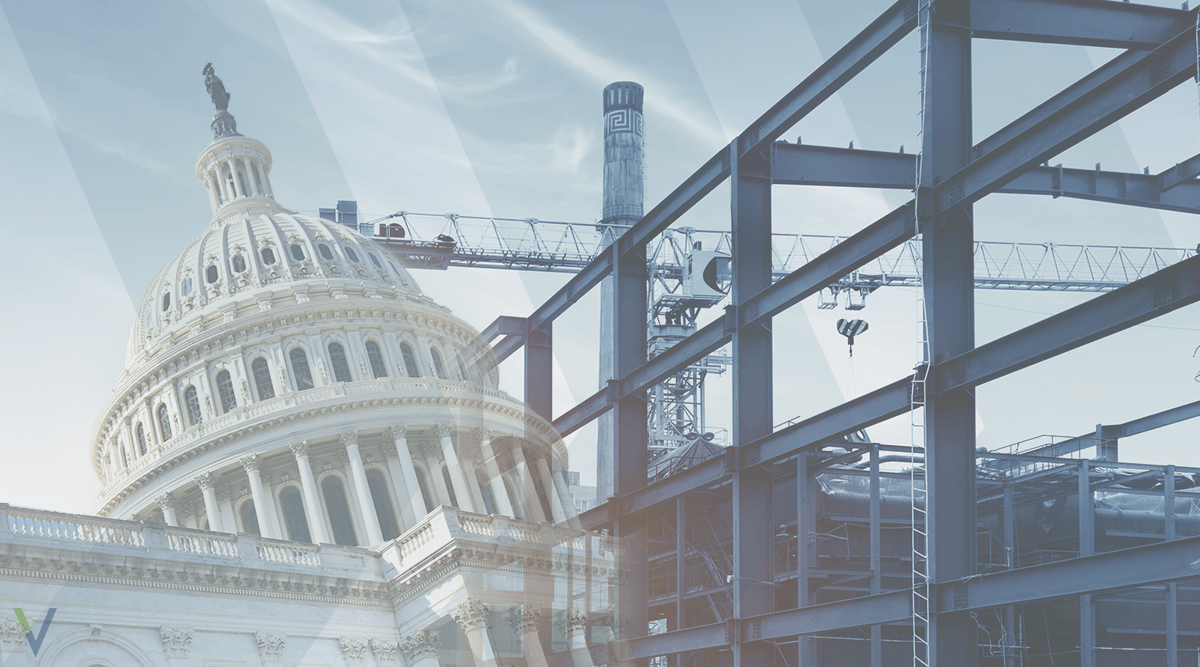Market Outlook Fed Watch
Excerpts of 12/2021 Press Conference and What It Means for Construction

February 14, 2022
Recent Blogs
- The Feds New Normal
- Market Outlook Fed Watch Part 2
- The Bipartisan Infrastructure Plan and Construction Costs
- Steel Industry Volatility, Risks & Risk Mitigation
- Total Benefit - HVAC
- The Ins and Outs of Insulated Concrete Forms
- Mini Construction Market Update
- How Do You Price an Elephant
- What if This is the Recession?
- Where Did All the Wood Go
The Federal Reserve has reached another turning point in its history. The unprecedented monetary and fiscal stimulus injected into the economy at the onset of the pandemic has had a rapid effect on financial markets, successfully preventing a sudden recession and hardship in the economy. After many months of stimulus, it seems that rapid removal of that stimulus will be required to halt the opposite effect of price spirals and excess demand. This has brought the anticipated timelines of an end to stimulus forward by many months. Responsiveness to economic realities is part of the “new normal”, so, as events unfold over the course of this year, we should be ready for significant moves by both monetary and fiscal policymakers.
Construction, particularly residential and infrastructure, is a sector of the economy that could experience a positive long-term structural shift, much as other sectors could see long-term declines, due to the realities of a post-pandemic world.
Below are bullet point interpretations of the December press conference with the Federal Reserve Chair, Powell.
GDP and job growth strong – maximum participation rates are declining due to pandemic and aging population, so the Fed is likely to target full employment at a lower level than pre-pandemic – total employment levels grow slowly after long recessions
“FOMC participants continue to foresee rapid growth. As shown in our Summary of Economic Projections (SEP), the median projection for real GDP growth stands at 5.5 percent this year and 4 percent next year. Amid improving labor market conditions and very strong demand for workers, the economy has been making rapid progress toward maximum employment. Job gains have been solid in recent months, averaging 378,000 per month over the last three months. The unemployment rate has declined substantially – falling 6/10 of a percentage point since our last meeting and reaching 4.2 percent in November. The recent improvements in labor market conditions have narrowed the differences in employment across groups, especially for workers at the lower end of the wage distribution. Labor force participation showed a welcome rise in November—but remains subdued, in part reflecting the aging of the population and retirements. In addition, some who otherwise would be seeking work report that they are out of the labor force because of factors related to the pandemic, including caregiving needs and ongoing concerns about the virus. At the same time, employers are having difficulties filling job openings, and wages are rising at their fastest pace in many years.”
The Fed now sees true inflation in a broader range, so they will act to contain
“Supply and demand imbalances related to the pandemic and (to) the reopening of the economy has continued to contribute to elevated levels of inflation. Bottlenecks and supply constraints are limiting how quickly production can respond to higher demand in the near term. These problems have been larger and longer-lasting than anticipated, exacerbated by waves of the virus. As a result, overall inflation is running well above our 2 percent longer-run goal and will likely continue to do so well into next year. While the drivers of higher inflation have been predominantly connected to the dislocations caused by the pandemic, price increases have now spread to a broader range of goods and services. Wages have also risen briskly. Thus far, wage growth has not been a major contributor to the elevated levels of inflation. Persistent real wage growth in excess of productivity (growth) could put upward pressure on inflation. Like most forecasters, we continue to expect inflation to decline to levels closer to our 2 percent longer-run goal by the end of next year. The median inflation projection of FOMC participants falls from 5.3 percent this year to 2.6 percent next year; this trajectory is notably higher than projected in September.”
Interest rates are set to rise from 0 to 0.9% by end of 2022 and back to normal by end of 2024
“With inflation having exceeded 2 percent for some time, the Committee expects it will be appropriate to maintain this target range until labor market conditions have reached levels consistent with the Committee's assessments of maximum employment. All FOMC participants forecast that this remaining test will be met next year. The median projection for the appropriate level of the federal funds rate is 0.9 percent at the end of 2022, about ½ percentage point higher than projected in September. Participants expect a gradual pace of policy firming, with the level of the federal funds rate generally near estimates of its longer-run level by the end of 2024.”
The Fed will rapidly taper quantitative measures ending mid-March
“The Committee also decided to double the pace of reductions in its asset purchases. Beginning in mid-January, we will reduce the monthly pace of our net asset purchases by $20 billion for Treasury securities and $10 billion for agency mortgage-backed securities. If the economy evolves broadly as expected, similar reductions in the pace of net asset purchases will likely be appropriate each month, implying that increases in our securities holdings would cease by mid-March-a few months sooner than we anticipated in early November. We are phasing out our purchases more rapidly because, with elevated inflation pressures and a rapidly strengthening labor market, the economy no longer needs increasing amounts of policy support. And, even after our balance sheet stops expanding, our holdings of securities will continue to foster accommodative financial conditions.”
As of 12/15, the Fed did not see delta or omicron variants derailing the recovery
“Moving forward the end of our taper by a few months is really an appropriate thing to do. Omicron doesn't really have much to do with that.”
The new normal means that the Fed will act on evidence, not expectation, which has led to the quicker adaptation of policy
“We got the ECI reading on the eve of the November meeting, and it was very high, 5.7 percent reading for the employment compensation index for the third quarter, not annualized, for the third quarter. And I thought for a second there whether we should increase our taper. We decided to go ahead with what we had "socialized." Then, right after that, we got a very strong employment report and revisions to prior readings, and no increase in labor supply. And the Friday after that, we got the CPI, which was a very hot, high reading. At that point, I thought we needed to look at speeding up the taper”
While responding to goods and service Inflation, the Fed forecasts this trending down - their other main watches are wage levels outpacing productivity growth, and rent (owner equivalent rent) Inflation
“Wages are not a big part of the high-inflation story that we're seeing. As you look forward, let's assume that the goods economy does sort itself out, and supply chains get working again, and maybe there's a rebalancing back to services and all that kind of thing. But what that leaves behind is the other things that can lead to persistent inflation. In particular, we don't see this yet, but if you had something where wages increases were persistently above productivity growth, that puts upward pressure on firms, and they raise prices. But with the kind of hot labor market readings wages we're seeing, it's something that we're watching. And the other thing, of course, is the owners' equivalent rent. Unlike the things that are causing the inflation now, this is economically sensitive—and so would be expected to move up. And so, as some things go down, the question is: Where will we be when we come out the other side of this? And we need to keep our eyes on those things.”
The labor market is tight which means both goods and services Inflation and high employment point to restricting policy
“Labor force participation, the unemployment rate, the JOLTS data get a lot of focus. And wages, that's, that's really one of the great signals. The quits rate is another one. The quits rate is really one of the very best indicators, according to a lot of labor economists, because people quit because they feel like they can get a better job. And there's record amounts, historically high levels of that going on—suggesting, again, that you've got a very tight labor market. “
Lots of good reasons people are not rushing back to work
“For certain people, they don't want to go back in the labor force because either they're medically vulnerable or they're not comfortable going back while COVID is still everywhere. That's one thing. The lack of availability of childcare made for caretakers is certainly part of it not just for children, but for older people. It has been pointed out by many that the stock market is high, people's portfolios are stronger they may go back to being a one-income rather than a two-income family. The same thing with people's houses. The equity they have in their home might have doubled. And they might make reach the same conclusion. People have savings on their balance sheet because of forced savings because they couldn't spend on travel and things like that, and because of government transfers. So, we have a situation where we've had a shock to labor force participation that is not unwinding as quickly as expected. A good part of it is voluntary. This is how they want to maximize their welfare.”
Richard Vermeulen
Senior Principal
Richard has been in the industry for over 3 decades. He is the creator of the Quarterly Market Outlook and chairs the Vermeulens Forum.












